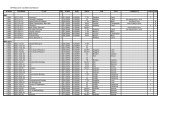Kenwood TH-D7A
Kenwood TH-D7A
Kenwood TH-D7A
You also want an ePaper? Increase the reach of your titles
YUMPU automatically turns print PDFs into web optimized ePapers that Google loves.
NOTICES TO <strong>TH</strong>E USER<br />
ATTENTION (U.S.A. Only)<br />
Nickel-Cadmium batteries must be replaced or<br />
disposed of properly.<br />
State laws may vary regarding the handling and<br />
disposal of Nickel-Cadmium batteries.<br />
Please contact your authorized KENWOOD dealer for<br />
more information.<br />
One or more of the following statements may be<br />
applicable:<br />
FCC WARNING<br />
This equipment generates or uses radio frequency energy. Changes or<br />
modifications to this equipment may cause harmful interference unless<br />
the modifications are expressly approved in the instruction manual. The<br />
user could lose the authority to operate this equipment if an<br />
unauthorized change or modification is made.<br />
INFORMATION TO <strong>TH</strong>E DIGITAL DEVICE USER REQUIRED BY <strong>TH</strong>E<br />
FCC<br />
This equipment has been tested and found to comply with the limits for a<br />
Class B digital device, pursuant to Part 15 of the FCC Rules. These<br />
limits are designed to provide reasonable protection against harmful<br />
interference in a residential installation.<br />
This equipment generates, uses and can generate radio frequency<br />
energy and, if not installed and used in accordance with the instructions,<br />
may cause harmful interference to radio communications. However,<br />
there is no guarantee that the interference will not occur in a particular<br />
installation. If this equipment does cause harmful interference to radio<br />
or television reception, which can be determined by turning the<br />
equipment off and on, the user is encouraged to try to correct the<br />
interference by one or more of the following measures:<br />
• Reorient or relocate the receiving antenna.<br />
• Increase the separation between the equipment and receiver.<br />
• Connect the equipment to an outlet on a circuit different from that to<br />
which the receiver is connected.<br />
• Consult the dealer for technical assistance.<br />
PRECAUTIONS<br />
Please observe the following precautions to prevent<br />
fire, personal injury, or transceiver damage:<br />
• Do not transmit with high output power for<br />
extended periods. The transceiver may overheat.<br />
• Do not modify this transceiver unless instructed by<br />
this manual or by KENWOOD documentation.<br />
• When using a regulated power supply, connect the<br />
specified DC cable (option) to the DC IN jack on<br />
the transceiver. The supply voltage must be<br />
between 5.5 V and 16 V to prevent damaging the<br />
transceiver.<br />
• When connecting the transceiver to a cigarette<br />
lighter socket in a vehicle, use the specified<br />
cigarette lighter cable (option).<br />
• Do not expose the transceiver to long periods of<br />
direct sunlight nor place the transceiver close to<br />
heating appliances.<br />
• Do not place the transceiver in excessively dusty<br />
areas, humid areas, wet areas, nor on unstable<br />
surfaces.<br />
• If an abnormal odor or smoke is detected coming<br />
from the transceiver, turn OFF the power<br />
immediately and remove the battery case or the<br />
battery pack from the transceiver. Contact your<br />
authorized KENWOOD dealer, customer service,<br />
or service station.<br />
i

















